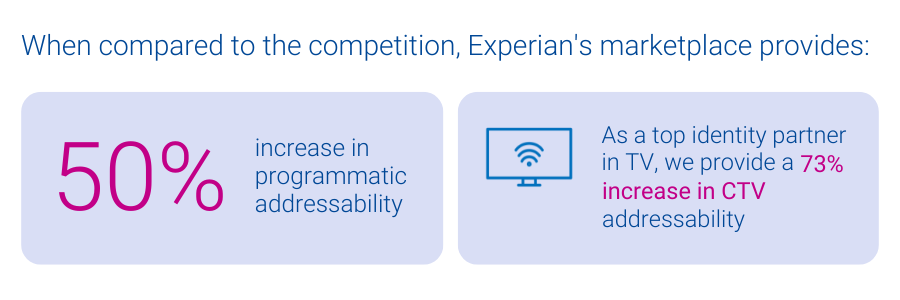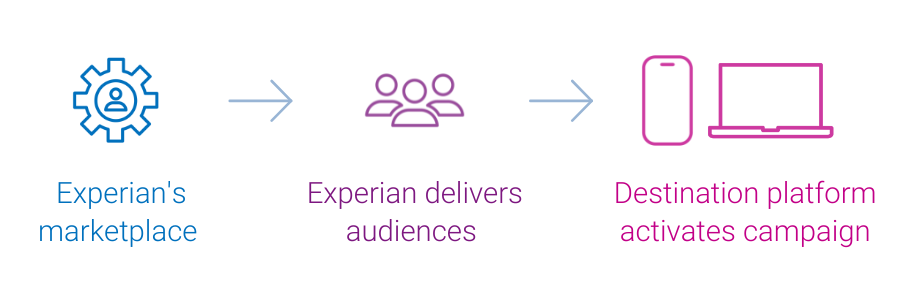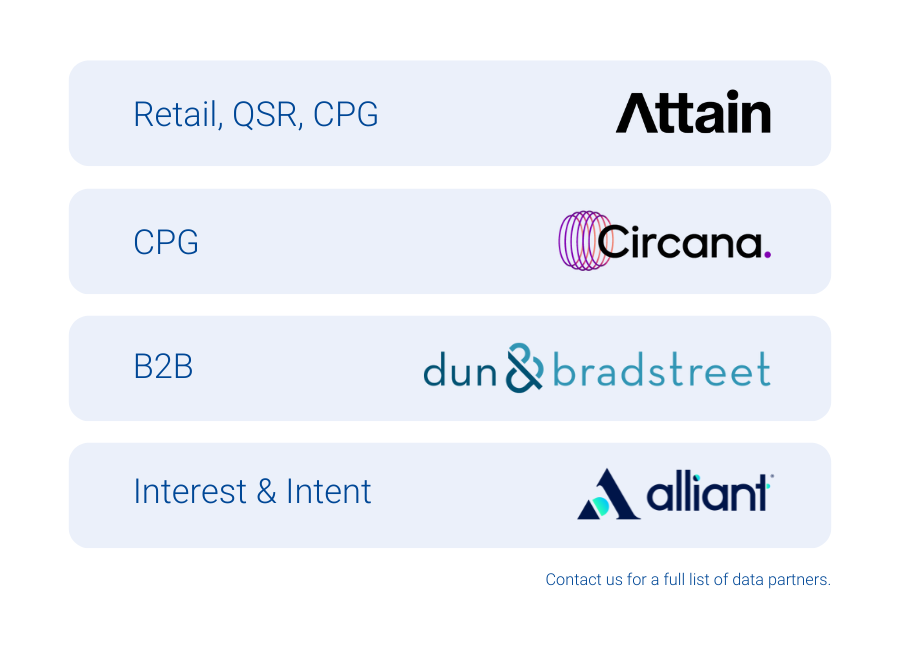
In a perfect world, we’d all have a single, go-to grocery store that carried everything on our shopping list – fresh produce, gourmet coffee beans, rare spices, and maybe even that special-grade olive oil, right alongside our wholesale bulk purchases at unbeatable prices. It would be convenient and efficient, and it’d save a lot of driving around town.
The changing data marketplace: From one-stop shop to specialized selection
For a long time, data buyers enjoyed something similar in their world: a small set of large-scale data marketplaces that offered a wide array of audiences, making it easy to load up on whatever you needed in one place. Not only are there fewer places to pick everything up, but new factors like privacy and signal deprecation are placing a spotlight on quality and addressability.
Just as our dinner plans are growing more ambitious insofar as we want health, flavor, value, and convenience all in one place – so are our data strategies. Instead of a single steak-and-potatoes meal, today’s data marketplace operators might be cooking up a complex menu of campaigns.
“Experian has been a longstanding partner of DISH Media, and we’re excited to be an early adopter of their marketplace which leverages the foundation of their identity solutions to ensure maximum cross-channel reach as we look to expand the breadth and depth of data we use for addressable TV.”
Kemal Bokhari, Head of Data, Measurement & Analytics, DISH Media
As a result, data buyers are beginning to shop around. Some still rely on large-scale marketplaces for familiar staples, but now they have reasons to explore other options. Some are turning to providers known for offering top-tier, transparently sourced segments. Others are focusing on specialty providers that excel in one area.
A more selective approach to data buying
In this environment, choosing where to “shop” for data is becoming more deliberate and selective. Data buyers aren’t just thinking about broad scale; they’re looking to prioritize quality, durability, data privacy, and differentiation. They need to place higher value on data marketplaces that can maintain audience addressability over time, despite signal loss. Sometimes, that means accepting a smaller assortment in exchange for tighter vetting and more reliable targeting. Other times it means mixing and matching – stopping by one marketplace for premium segments and another for cost-friendly, wide-reaching data sets. Either way, they can benefit from having more choices.
“Experian has been a longstanding partner of DISH Media, and we’re excited to be an early adopter of their marketplace which leverages the foundation of their identity solutions to ensure maximum cross-channel reach as we look to expand the breadth and depth of data we use for addressable TV.”
Kemal Bokhari, Head of Data, Measurement & Analytics, DISH Media
Experian’s marketplace: A trusted source for high-quality data
Experian’s vetted and curated blend of data partners and vertically-aligned audiences offers a trusted specialty store for data buyers. Experian’s marketplace, powered by identity graphs that include 126 million households, 250 million individuals, and 4 billion active digital IDs, enables partner audiences to be easily activated and maintain high addressability across display, mobile, and connected TV (CTV) channels. In particular, Experian’s marketplace provides:


The future of data marketplaces: Precision and flexibility matter
The evolution of data marketplaces reflects the industry’s shifting priorities. Data buyers seek specificity, reliability, and adaptability to align with their diverse campaign needs. The best data strategy, much like the best grocery run, isn’t about grabbing everything in one place – it’s about carefully selecting the right ingredients to create the perfect recipe for success. This shift underscores the importance of flexibility and precision as data buyers navigate a landscape shaped by privacy regulations, signal loss, and evolving consumer expectations.

As data marketplaces adapt to meet these demands, they are redefining what it means to deliver value. Experian’s marketplace enables buyers to strike the perfect balance between reach and quality by offering enhanced match rates, precise audience planning, and seamless distribution. In this new era, data buyers have the tools and options to craft campaigns that are impactful and aligned with the increasingly selective and privacy-conscious digital landscape. The key is recognizing that today’s data strategy is about utilizing the strengths of many to create a cohesive and effective whole.
If you’re interested in learning more about Experian’s marketplace or becoming an active buyer or seller in our marketplace, please contact us.
Latest posts

Adam Garone is the CEO & co-founder of Movember, the annual world-wide charity movement dedicated to changing the face of men's health – all through the power of the moustache. To date, over 3 million moustaches have been grown and supported for Movember, raising more than $440 million to change the face of men's health. Adam kicked off day two of the EMS Client Summit by saying he’s a lucky guy because he gets “to wear a 1993 porn stash year-round.” That line got a laugh, but Adam’s storytelling around Movember really caught the attention of Summit attendees. Adam had learned that prostate cancer affects as many men as breast cancer does women, and while discussing this fact over beers with his brother in Australia, the idea for Movember was born. They took the Aussie slang for moustache (“mo”) and combined it with “November” (a good month for men to grow them) to create the name. That was in 2003 and over the last decade, Movember has become a global movement around prostate and testicular cancer awareness, as well as men’s mental health issues. Watch his full presentation below: [Watch video on YouTube] Here are some cool facts cited by Adam: Everyone who grows a moustache for Movember is a “celebrity ambassador.” Last year, 2.7 billion conversations about Movember and men’s health issues were generated during the month of November. Most foundations go out with a “fear-based message” (x number of men die from cancer each year, for example). Movember has never done that. They encourage nicknames (i.e., participants are called “mo-bros”) and want people to have fun with it. Adam’s message: don’t be part of it because you’re scared, but because you will be fine and you get to help others. Each year they totally revamp their brand, changing the look, feel and tone. A few years ago their theme was “The Modern Gentleman” and last year it was “Movember and Sons,” and played off the relationship between father and son. Movember raised $145 million last year. They put 10% of the funds into a pool that goes towards research around other diseases. Adam says this kind of collaboration is to help reduce the heaving competition amongst charities that typically compete for donations. Key takeaways when it comes to growing a foundation (or business) from the ground up: Start with a great idea – naivety is good Rely on strong leadership –have a clear vision and detailed plan and work really, really hard Recruit amazing people – preserve culture and values During rapid growth, keep it simple—stay true to your core Brand management is key – sometimes you have to say no to potential partners because they don’t fit with your brand (in a humble way, of course) Know your customers – inspire them to become your ambassadors Partnerships are key Never underestimate a room full of people

These days, there are a number of buzzwords being thrown around the marketing industry and the data management space. One of the biggest? Say it with me: Big Data. NPR argued last December that ‘big data’ should’ve been the “word of the year,” in part due to the re-election of President Barack Obama. Obama’s campaign managers didn’t let the Republicans’ monetary advantage discourage them. Instead, they gathered information on their voters and compiled important analytics based on that information. By handling this mass of data in an organized and well thought out process, they were able to more effectively appeal to voters and ultimately win the re-election. Marketers and corporations across the country were inspired by the campaign’s success, and have turned to big data to solve their problems as well. Anyone who catches the news on a regular basis, shops online, or owns a smartphone can see this evolution firsthand. However, it’s worth mentioning that this progression doesn’t necessarily mean “big understanding” or “big information.” Many companies are faltering in their efforts to harness big data and make real use of it. The pool of information is constantly changing, and as so many businesses rush to gather the data in real-time, it becomes even more challenging to keep pace and actively comprehend information as it becomes available. And the challenges go beyond the initial harnessing of the data. As big data continues to grow, companies are running into issues of incorrect and duplicate data in their systems. This erroneous data is a result of poor processes that companies have in place, and oftentimes begins at the point of data input. For a number of companies, data input is performed on a daily basis via their call centers. When incorrect data is recorded, it prevents sales representatives from getting leads in a timely manner, and hampers them further when they try to contact the correct individuals seeking assistance. The resulting slower response time then goes on to impact a company’s SLA and credibility to the population they serve. There is no doubt that when processed correctly, big data can be integral to a company looking to improve their understanding of the customer’s needs and wants. But data quality is an important consideration during the transition, and one that must be confronted before big data can reveal all it has to offer. To learn more about big data and how it relates to the data quality initiatives that may be taking place within your organization, watch Experian QAS’ webinar, “Ensuring Data Quality in your Big Data Initiative.” Learn more about the author, Erin Haselkorn

2013 has been a milestone year for those lobbying on behalf of expanded rights of Lesbian, Gay, Bisexual and Transgendered (LGBT) Americans. With 12 states and the District of Columbia now formally recognizing same sex marriages and two highly anticipated rulings from the U.S. Supreme Court expected shortly, the momentum is currently on the side of those seeking greater recognition and support of LGBT-related issues. The speed with which public attitudes have shifted towards greater acceptance of LGBT individuals and their causes has left many marketers scrambling to devise plans that are not only inclusive of LGBT consumers, but in many instances, designed to overtly and publically court this influential and growing consumer segment. The 2013 LGBT consumer report out from Experian Marketing Services delivers insights marketers need to better understand the market that is on everyone’s radar. In this first of a series of blog posts, we’ll highlight key data from the report. Readers can download the full report at any time here. Living out Loud In 2006, when Experian Marketing Services first began measuring sexual orientation among respondents to our Simmons® National Consumer Study, we found that 3.4% of all non-Hispanic adults self-identified as either lesbian, gay, bisexual or transgendered (LGBT), a figure consistent with what leading LGBT researchers predicted at the time. However today, 4.3% of the non-Hispanic adult population self-identifies as LGBT, a figure that has risen slowly but steadily year-after-year. Younger adults have consistently been more likely to identify as LGBT, and in fact today, 5.8 percent of 18 to 34 year olds say they are lesbian, gay, bisexual or transgendered. As a result, the adult LGBT population predictably skews towards the younger age cohorts. Specifically, 36% of LGBT adults today are aged 18 to 34 versus 26% of the heterosexual population in that age range. Likewise, while 20% of heterosexual adults are age 65 and older, just 16% of LGBT adults are in this age range, though our data shows that the share of adults age 65 and older identifying as LGBT has also risen. Home and Family As a growing number of U.S. states pass laws recognizing same-sex marriages and civil unions, we see an increasing percentage of gay and lesbian Americans reporting that they are married. In 2007, for example, when only Massachusetts allowed same-sex marriage, 8% of gay men and 14% of lesbian women said they were married. Today, 17% of gay men and 16% of lesbian women are married. Marriage rates among lesbian and gay adults still lag well behind those of heterosexuals, but the gap is closing from both sides. In fact, while marriage rates are rising among lesbians and gays, they’re falling among heterosexuals. Today, 58% of heterosexual men and 53% of heterosexual women are married, compared to 60% of heterosexual men and 55% of heterosexual women who were married in 2007. The Pink Dollar Income levels are important to consider when targeting consumers, but more important is determining the amount of money left over for non-essentials after the other bills are paid. Despite earning nearly identical salaries, gay men have lower annual household discretionary expenditures than heterosexual men. Likewise, lesbian households have fewer dollars than those of heterosexual women to spend on non-essentials. This is mostly likely due to the fact that both lesbian and gay adults tend to reside in larger cities where the cost of living can be considerably higher than average. Interestingly, when household size is brought into the equation, we see that gay males actually have higher discretionary spending per capita than heterosexual men. In fact, gay men live in households that devote $6,794 per capita annually to non-essentials, which is $753 more than what heterosexual men spend. Forthcoming posts from this series will include insights into the automotive and food vertical markets; the mobile habits of LGBT consumers; and an examination of online visitors to LGBT content sites. Don’t want to wait? Download the full report now. Also, learn more about the Simmons LGBT Consumer Study, the only syndicated, national probability sample survey that measures the lifestyles, attitudes, media habits and brand preferences of the LGBT population giving marketers actionable insights into this powerful consumer segment that can be directly compared with those of heterosexuals.